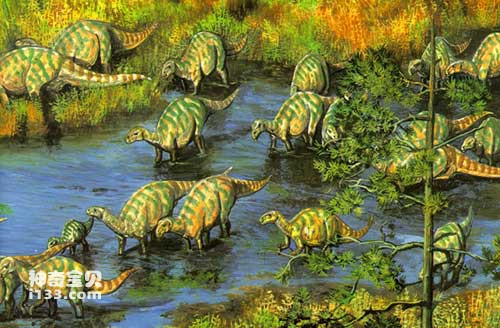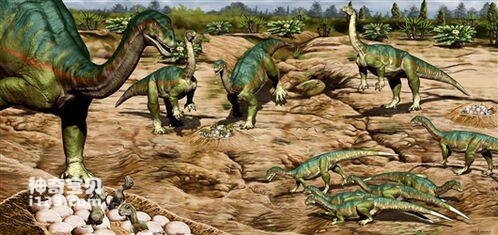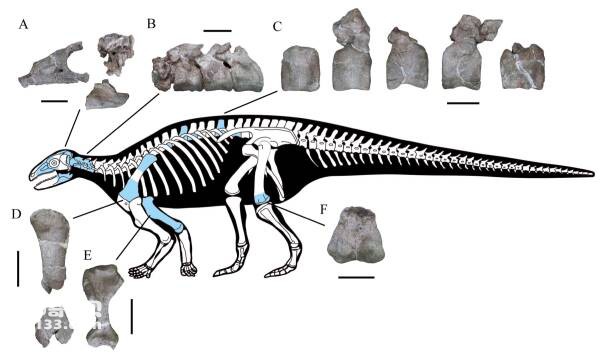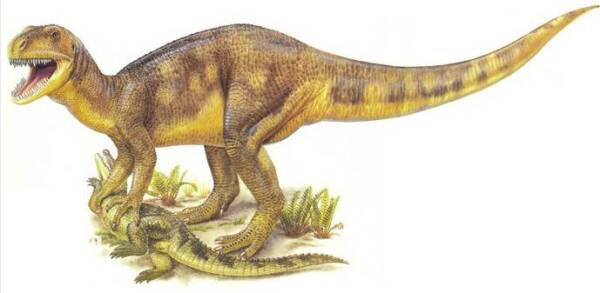1. The story of Mr. and Mrs. Mantel
There is a small place called Lewes in Sussex, southern England. 180 years ago, a country doctor named Mantel once lived here. Mr. Mantel was full of curiosity about nature and especially loved collecting and studying fossils. When he was not practicing medicine, he often took his wife to climb mountains and wade in rivers to search for and collect fossils. His footprints were all over the ditches and ridges with exposed rock formations around him. Over time, Mrs. Mantel also became a "friend of nature" and an expert in fossil collecting.

Iguanodon
One day in March 1822, the weather was very cold, but Mr. Mantel still went out to see patients as usual. The wife was waiting for her husband to come back at home, always worrying whether he would catch a cold. Later, Mrs. Mantel couldn't sit still anymore, so she took a piece of her husband's clothes and went out to meet him in the direction of his visit. She was walking on a road that was being built. The newly dug steep walls on both sides of the road exposed layers of rocks. She habitually observed the newly exposed rock formations on both sides while walking. Suddenly, something shiny caught her attention. "What is this?" she said to herself, and stepped forward to take a closer look. Wow! It turned out to be some strange-looking animal tooth fossils. The fossil teeth were so big that Mrs. Mantel had never seen such large teeth. The excitement of the discovery made Mrs. Mantel forget to give her husband clothes. She carefully removed the fossils from the rock formations and brought them home.
Later in the evening, Mr. Mantel returned home. When the lady presented the newly collected fossils to him, he was stunned. He had seen the fossil teeth of many ancient animals, but none of them were similar to such a large and strange tooth.
Soon afterwards, Mr. Mantel found many such tooth fossils and related bone fossils near the location where the fossils were found. In order to find out what animals these fossils belonged to, Mr. Mantel brought these fossils to the French naturalist Cuvier and asked the most famous scholar in the world at that time to identify them.
To be honest, Cuvier had never seen such fossils, and all the books and papers he had read written by senior scientists had never mentioned such fossils. However, Cuvier still made a judgment based on his considerable zoological knowledge. He believed that the teeth were from rhinoceros and the bones were from hippopotamus, and they were not too old.
Mr. Mantel was very doubtful about Cuvier's identification. He thought Cuvier's conclusion was too hasty. He decided to continue his research. From then on, whenever he had the chance, he would go to museums around the world to compare specimens and look up information.

One day two years later, he accidentally met a naturalist working at the Royal Academy Museum in London. The man was studying a modern lizard living in Central America, the iguana. So Mr. Mantel took those fossils to the Royal Academy Museum in London and compared them with the iguana teeth collected by naturalists, and found that the two were very similar. The overjoyed Mr. Mantel concluded that the fossils belonged to an extinct ancient reptile similar to the iguana, and named it "iguana's teeth."
Later, as more and more fossil materials were discovered, humans have a deeper and deeper understanding of these ancient animals. We know that the so-called "iguana teeth" are actually members of a wide variety of dinosaur families. ; It is indeed a reptile like an iguana, but its relationship to the real iguana is further distant than to other species of dinosaurs! However, according to the rules of biological nomenclature, the Latin text of the species name of this earliest scientifically recorded dinosaur has not changed, and it still means "iguana's tooth". However, its Chinese name is translated as Iguanodon.
So remember: Iguanodon is the earliest dinosaur recorded in the history of science. At the same time, don’t forget the name Mantel and his nature-loving wife.

2. Plot’s story
The story of Mrs. Mantel's discovery of dinosaurs is indeed very romantic, and Mr. Mantel's ability to explore the issue of dinosaur ownership in a rigorous and realistic manner is indeed the first step for humans to scientifically study and understand dinosaurs.
But in history, humans have discovered dinosaur fossils long ago, but due to the limited level of knowledge at that time, they could not correctly interpret these fossils.
As early as 1,000 years ago during the Jin Dynasty in my country, dinosaur fossils were discovered in Wucheng County, Sichuan Province. However, people at the time did not know that they were the remains of dinosaurs, but regarded them as the bones left by the legendary dragon.
Based on clues found in a historical novel "Mr. Milgan's Wife", a researcher named Haselted from the University of Reading in the UK recently announced that he Finally, the following facts were discovered: In 1677, an Englishman named Plott wrote a natural history book about Oxford County. In this book, Plott describes a huge fossilized leg bone found in a quarry in the parish of Carlovella. Plott drew a good illustration of the fossil and pointed out that the thigh bone was not that of a cow, a horse, or an elephant, but that it belonged to a giant even larger than either of them.
Although Plott did not recognize the fossil as belonging to a dinosaur, or even connect it with reptiles, the specimen he documented and illustrated has been identified by later paleontologists as a species called The thigh bone of the Megalodon dinosaur, and this fossil was discovered 145 years before the Mantells discovered Iguanodon. Therefore, Haselted believed that Plot should be the first discoverer and recorder of dinosaur fossils.

3. Megalosaurus - "The Big Lizard of the Quarry"
Although the ancient Chinese discovered dinosaurs as early as the Jin Dynasty, they thought they were the bones of legendary dragons; although Mr. Plot discovered and described Megalodon as early as 1677, he mistakenly thought they were giants. The remains of Iguanodon; although the Mantells discovered the Iguanodon fossil in 1822, they did not publish it until 1825.
While Iguanodon was being identified, British geologist Buckland took the lead in publishing the world's first scientific report on dinosaurs in 1824, reporting on a dinosaur mandible fossil collected in a quarry - Megalosaurus. Buckland believed that this was a new type of reptile, and the Latin name "Megalosaurus" means "quarry lizard".
animal tags:
We created this article in conjunction with AI technology, then made sure it was fact-checked and edited by a Animals Top editor.